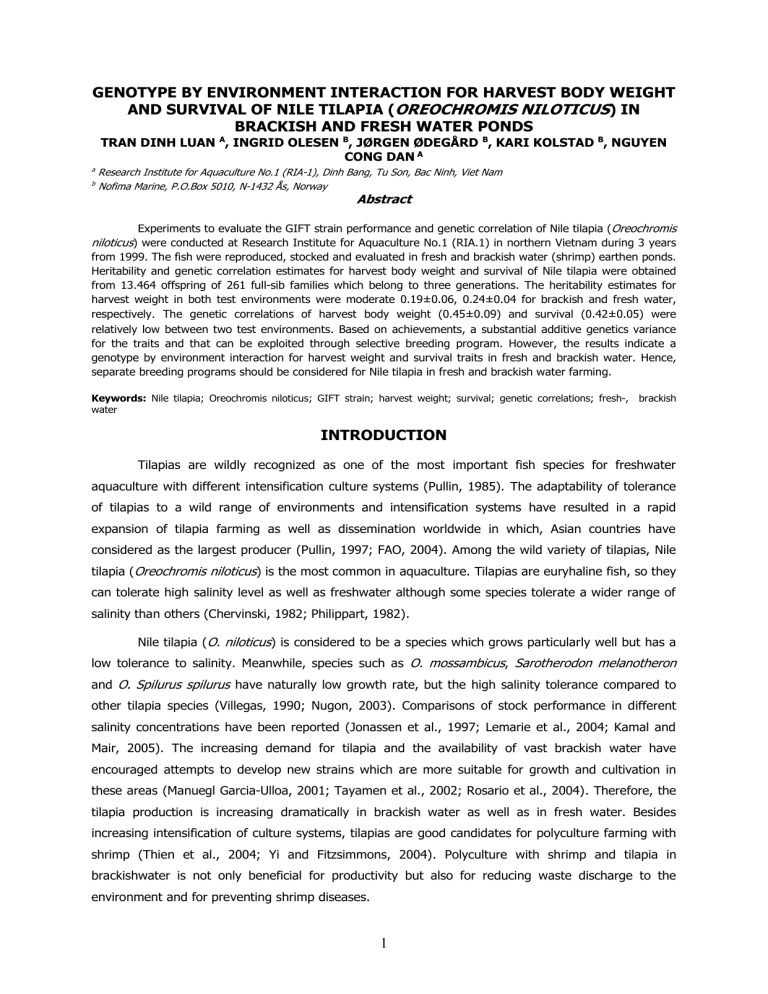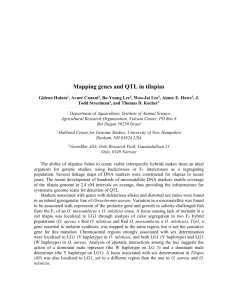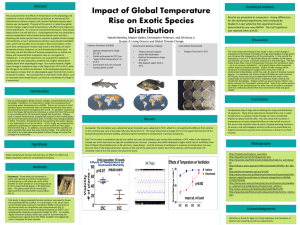Genetic parameters for harvest body weight and survival of Nile

GENOTYPE BY ENVIRONMENT INTERACTION FOR HARVEST BODY WEIGHT
AND SURVIVAL OF NILE TILAPIA ( OREOCHROMIS NILOTICUS) IN
BRACKISH AND FRESH WATER PONDS
TRAN DINH LUAN A , INGRID OLESEN B , JØRGEN ØDEGÅRD B
CONG DAN A
, KARI KOLSTAD B , NGUYEN a Research Institute for Aquaculture No.1 (RIA-1), Dinh Bang, Tu Son, Bac Ninh, Viet Nam b Nofima Marine, P.O.Box 5010, N-1432 Ås, Norway
Abstract
Experiments to evaluate the GIFT strain performance and genetic correlation of Nile tilapia ( Oreochromis niloticus ) were conducted at Research Institute for Aquaculture No.1 (RIA.1) in northern Vietnam during 3 years from 1999. The fish were reproduced, stocked and evaluated in fresh and brackish water (shrimp) earthen ponds.
Heritability and genetic correlation estimates for harvest body weight and survival of Nile tilapia were obtained from 13.464 offspring of 261 full-sib families which belong to three generations. The heritability estimates for harvest weight in both test environments were moderate 0.19±0.06, 0.24±0.04 for brackish and fresh water, respectively .
The genetic correlations of harvest body weight (0.45±0.09) and survival (0.42±0.05) were relatively low between two test environments. Based on achievements, a substantial additive genetics variance for the traits and that can be exploited through selective breeding program. However, the results indicate a genotype by environment interaction for harvest weight and survival traits in fresh and brackish water. Hence, separate breeding programs should be considered for Nile tilapia in fresh and brackish water farming.
Keywords: Nile tilapia; Oreochromis niloticus; GIFT strain; harvest weight; survival; genetic correlations; fresh-, brackish water
INTRODUCTION
Tilapias are wildly recognized as one of the most important fish species for freshwater aquaculture with different intensification culture systems (Pullin, 1985). The adaptability of tolerance of tilapias to a wild range of environments and intensification systems have resulted in a rapid expansion of tilapia farming as well as dissemination worldwide in which, Asian countries have considered as the largest producer (Pullin, 1997; FAO, 2004). Among the wild variety of tilapias, Nile tilapia (
Oreochromis niloticus
) is the most common in aquaculture. Tilapias are euryhaline fish, so they can tolerate high salinity level as well as freshwater although some species tolerate a wider range of salinity than others (Chervinski, 1982; Philippart, 1982).
Nile tilapia (
O. niloticus
) is considered to be a species which grows particularly well but has a low tolerance to salinity. Meanwhile, species such as
O. mossambicus
,
Sarotherodon melanotheron
and
O. Spilurus spilurus
have naturally low growth rate, but the high salinity tolerance compared to other tilapia species (Villegas, 1990; Nugon, 2003). Comparisons of stock performance in different salinity concentrations have been reported (Jonassen et al., 1997; Lemarie et al., 2004; Kamal and
Mair, 2005). The increasing demand for tilapia and the availability of vast brackish water have encouraged attempts to develop new strains which are more suitable for growth and cultivation in these areas (Manuegl Garcia-Ulloa, 2001; Tayamen et al., 2002; Rosario et al., 2004). Therefore, the tilapia production is increasing dramatically in brackish water as well as in fresh water. Besides increasing intensification of culture systems, tilapias are good candidates for polyculture farming with shrimp (Thien et al., 2004; Yi and Fitzsimmons, 2004). Polyculture with shrimp and tilapia in brackishwater is not only beneficial for productivity but also for reducing waste discharge to the environment and for preventing shrimp diseases.
1
The main objective of this study is to estimate heritability for harvest body weight and survival in each test environment and genetic correlations for the corresponding trait between two environments of Nile tilapia (
O. niloticus
) in fresh and brackish water of Vietnam in order to improve understanding of tilapia growth and survival in fresh and brackish water farming.
MATERIAL AND METHODS
Experimental fish
The GIFT strain in this study was derived from 106 families from the fifth generation selected for growth rate of the Genetically Improved of farmed tilapia (GIFT) project at GIFT International foundation Inc., Philippines. The fish were imported to Research Institute for Aquaculture No.1
(RIA.1) in 1997 (ICLARM 1998), and further reared and reproduced in fresh water ponds at RIA.1 for those experiments.
For reproduction of fish, hierarchical mating design was applied. Each male was mated to two females in a mating hapas for fry collection. When females were ready to spawn, they were individually placed in 3 m 3 mating hapas with one male for natural spawning. Swim-up fry of the successful pairs mating were transferred to individual fine mesh nursing hapas and spawned females were removed to allow male mating with second female and production of a second batch of fry. The methodology used was as described in the manual of the GIFT technology (WorldFish Center, 2004).
All full sib families were kept separately in nursing hapas at the same density, feeding regime and in the same pond until tagging (average body weight of 12-15 g). A total of 60 fingerlings from each full-sib family were individually identified with electronic AVID PIT tags. Then 40 fish from each of these families were stocked in freshwater ponds, whereas the remaining 20 fish were acclimatized, before stocking in a brackishwater pond.
Test environments and acclimation
The tagged fish were stocked in fresh- and brackish water earthen ponds for testing of growth rate. Freshwater ponds were conducted at RIA.1, located near Hanoi, Northern Vietnam.
Brackishwater testing pond was conducted at a shrimp farm in Nghe An province, 300 km South of
Hanoi, Middle Vietnam. The salinity concentration increased approximately from 8.0 ppt. in August to
20.0 ppt. in December during the 3 years of the experiment (Fig.1). Average temperature during grow-out period was about 28 o C with a range of 25 o C to 34 o C. The temperature
20
18 recorded in the brackish water pond was slightly higher than in fresh water ponds and similar during three years.
Acclimation was conducted at
RIA.1 before transferring fingerlings to brackish water farm. Salt was mixed (well)
16
14
12
10
8
6
4
2
0
1
2
3
Aug.
Sept.
Oct.
Nov.
Dec.
Time (Months by year)
2
Figure 1. A plot of mean salinity level (ppt.) in the brackish water pond for different months and years.
with freshwater in tanks and then added to the fish tanks to increase salinity level up to level at the brackish water pond. The daily increase of salinity level was 2 ppt. and other environment factors such temperature, dissolve oxygen (DO) and pH was check regularly. Aeration was supplied to maintain sufficiently DO level in the tanks.
For each test environment and pond, the fish were stocked at a density of 2 – 3 fish per m 2 .
Two ponds fresh water ponds of 1,200 m 2 were used for the first two years, but in the third year they were replaced by one bigger pond. For brackish water, a pond of 1,000 m 2 was used. Fish were fed with pellet feed containing 22% crude protein at a rate of 2-3% of the fish biomass per day. The water level the in the ponds were maintained at 1.2 m. Other environmental factor such as temperature, DO, pH and salinity were recorded/monitored daily in both environments.
The data
The data on harvest weight and survival were obtained from the three selected generations of
O. niloticus
of the tilapia breeding program at RIA.1. A total of 261 full-sib families were produced
(Table 1). The number of sire, dam and progeny tested during three years are given in Table 1.
Individual weight at harvest was recorded of all fish survived. Selection was conducted in F1 - F3 after ranking with respect to breeding values for harvest weight in fresh water ponds.
Table 1. Number of sires, dams, and progeny belong to each generation and test environment
Generation Sire Dam Progeny tested
Freshwater Brackishwater Total
1
2
3
Total
50
50
46
146
90
90
81
261
3600
3600
3240
10440
1800
1800
1620
5220
5400
5400
4860
15660
Descriptive statistics for harvest weight and survival from the tagging to harvest for each environment is given in Table 2. The number of observations, general mean, standard deviation, coefficient of variation, sex ratio and survival rate were presented. Table 2 shows the mean harvest weight varied substantially between environments, high harvest weight of GIFT strain in freshwater compared to brackish water was estimated. The different sex ratio and weight at harvest of males and females obtained. Survival rate was 91.6% and 87% for of GIFT strain in fresh and brackish water test environment, respectively.
Table 2. The number of recorded fish (N), mean, standard deviation (SD), coefficient of variation
(CV), sex ratio and survival rate from tagging to harvest in each test environment
Environment N Mean
(g)
SD CV
(%)
Sex ratio
(M/F)
Survival
(%)
Freshwater 9144 179.56
a 56.25 31.33 1.14
Brackishwater 4320 160.19
b 67.81 38.58 0.97
Values in the same column with different superscripts are significantly different (P<0.05)
91.6
87.0
3
Data analyses
The heritability and genetic correlation between harvest body weights obtained in fresh water and brackish water was estimated using following univariate and multivariate linear animal model
(Model 1) as written in matrix notation as:
y = Xb + Z
1
a + Z
2
c + e
. (Model 1)
where y is a vector of the observed weight (g) at harvest, b is a vector of fixed effects
a is a vector of random additive genetic effects c is a vector of random common environment effect
e is a vector of random residual errors
X, Z
1
and
Z
2
are known design matrices
The heritability for each test environment and genetic correlation of survivals between in fresh and brackish water was estimated by using a threshold sire dam model (Model 2) assuming an underlying normal distributed liability. Survival of fish in fresh and brackish water was classified as a binary trait, based on whether or not the individual survived until harvest. In matrix notation, it can be written as:
Pr(Y
ijkl
= 1) = Pr(l
ijk
> 0) = Ф(µi + sj + dk + cjk)
(Model 2)
where
Y
ijk is survival at the end of testing period (0 = dead, 1 = alive)
µi
is the fixed effect of test
s
j
is the random additive genetic of sire j
d
k
is the random additive genetic of dam k
c
jk is the random common effect of full-sib family jk
Ф(.) is the cumulative standard normal distribution
According to model 1, the heritability for harvest body weigh was calculated as
h
2
= σ
a2
/ (σ
a2
+ σ
c2
+ σ
e2
)
, where
σ
a2
is additive genetic,
σ
c2 common environment and
σ
e2
residual variance. The heritability for survival trait was estimated following model 2 as
h
2
= 4σ
sd2
/ (2σ
sd2
+ σ
c2
+ σ
e2
)
, where
σ
2sd is additive genetic sire-dam variance,
σ
c2
common family variance, and
σ
e2
residual variance
(Residual variance was assumed to be 1 in threshold model).
The genetic correlation between harvest weight or survival in fresh and brackish water was estimated as r a(i,j)
= σ a(i,j)
/ σ a(i)
σ a(j)
, where σ a(i,j) is the covariance between the records in the two environments treated as two different traits, σ a(i)
, σ a(j) are genetic standard deviations (square root of the genetic variances) of the trait i and trait j, respectively.
A full pedigree for the individual fish provided the additive genetic relationships among fish for the analyses. Unfortunately, sex was not recorded for individual fish in brackish water at the second year. Hence, the genetic analyses of harvest weight in brackish water were based on data for only two generations (1999 and 2001). However, pedigree for all generations was utilized. The package
ASReml software (Gilmour
et al
., 2002) was used for these analyses.
4
RESULT AND DISCUSSIONS
The estimates of heritability for harvest weight and survival within each test environment are shown in Table 3. The heritability estimates for harvest weight in both environments were moderate and significantly different from zero (
P<0.05
). The heritability estimated for harvest weight in fresh water (0.24±0.04) was higher than the same trait obtained in brackish water (0.19±0.06). The heritability estimates for survival in both environments were also moderate and significantly different from zero (
P<0.05
). The estimate of heritability for survival in fresh water (0.27±0.04) was higher than the same trait in brackish water (0.20±0.06) (Table 3).
The estimates of heritability for harvest body weight are similar to those reported for
O. niloticus
(Gall and Bakar, 2002; Rutten
et al.
, 2005a; Rutten
et al
., 2005b) and
O. shiramus
(Maluwa
et al
., 2006), lower than estimates for
O. niloticus
reported by other authors (Kronert et al., 1989;
Bolivar and Newkirk, 2002; Ponzoni
et al.,
2005). Charo-Karisa
et al.
(2006) found much higher heritability of harvest weight for
O. niloticus
rearing under condition of low-input earthen pond.
Unfortunately, no estimate heritability for harvest weight of tilapia in brackish water was valid for comparison although a number of studies in brackish and salt water environment available. Therefore, discussion was based mainly on information available in freshwater environment. The heritability estimate for survival was much higher than reported by Charo-Karisa
et al.
(2006) for
O. niloticus
in low input fresh water ponds (0.03 - 0.14).
Table 3. Heritability h 2 ±se (on diagonal) and genetic correlations r g
±se (below diagonal) and correlation due to common family effect r f
±se (above diagonal) between harvest weights (HW) and survivals (S) in fresh and brackish water.
Fresh water
Brackish water
HW
S
HW
S
Fresh water
HW
0.24 ± 0.04
0.45 ± 0.09
S
0.27 ± 0.04
0.42 ± 0.05
Brackish water
HW
0.36 ± 0.13
0.19 ± 0.06
S
0.47 ± 0.11
0.20 ± 0.06
Estimates genetic and common family effect correlations between and within two test environments are shown in Table 3. The estimates of genetic correlation between harvest weights in fresh and brackish water (0.45±0.09) was relatively low (Table 3). Standard error of genetic correlation as relatively large, but the estimate was significantly different from zero (
P<0.05
). This is indicating that growth in fresh and brackish water is two different traits. The same was the case for survival analysis; the corresponding estimate of genetic correlation for survival in fresh and brackish water (0.42±0.05) was also relatively low, but significantly different from zero (
P<0.05
). Meanwhile, estimate family correlation for harvest weight and survival between fresh, brackish water environments was relative low with high standard error, 0.36±0.13 and 0.47±0.11 for harvest body weight and survival, respectively.
5
The low genetic correlation between harvest weight (Table 3) in the fresh and brackish water test environments suggests that G×E interaction is high or that the growth in the two environments can be considered as two different traits that are affected by different sets of genes or that the same genes have pleiotrophic effects. Most studies on G×E based on genetic correlations between harvest body weight of tilapias in different environments report of positive and moderate to high genetic correlations. Some of them were not significantly different from unity
(Eknath et al., 1993; Maluwa et al
., 2006), and some were low but significantly different from zero (Bentsen et al., 1998). Similarly, a relatively low genetic correlation (0.42±0.05) was obtained for survival in the two test environments in this study. It suggests that G×E interaction is also high for survival traits. Rye et al. (1990) estimated from low to medium genetic correlations between survival of Atlantic salmon in different periods (0.2 – 0.5).
A positive genetic correlation between survivals in ponds and tanks of
P. vannamei
is also reported (Gitterle
et al
., 2005). The results strongly indicate a significant G×E interaction for harvest weight and survival in Nile tilapia (GIFT strain) in the fresh and brackish water ponds investigated here.
CONCLUSIONS
The relatively low genetic correlation between harvest body weights in fresh and brackish water as well as for survivals in the corresponding environments, indicate a significant genotype x environment interaction. Hence, it suggests that two separate selection programs should be considered for improving these traits in the two environments.
ACKNOWLEDGEMENTS
This study was funded by Norwegian government via the Norwegian Agency for Development and cooperation (NORAD) and the Vietnamese government through the project SRV0033 “Building
Advanced Research, Education and Extension capacity of Research Institute for Aquaculture No.1” was undertaken from 1999 – 2001. Data analysis and preparation of the paper was carried out at
Nofima Marine and the Department of Animal and Aquaculture Sciences at the Norwegian University of Life Sciences (UMB) as a part of first author’s PhD studies funded by a State Educational Loan fund scholarship. We would also like to thank the staff at the RIA.1 for assistant during experiments.
REFERENCES
1.
Bentsen, H.B.,Eknath, A.E.,Palada-de Vera, M.S.,Danting, J.C.,Bolivar, H.L.,Reyes,
R.A.,Dionisio, E.E.,Longalong, F.M.,Circa, A.V.,Tayamen, M.M.,Gjerde, B., 1998. Genetic improvement of farmed tilapias: growth performance in a complete diallel cross experiment with eight strains of Oreochromis niloticus. Aquaculture 160, 145-173.
2.
Bolivar, R.B.,Newkirk, G.F., 2002. Response to within family selection for body weight in Nile tilapia (Oreochromis niloticus) using a single-trait animal model. Aquaculture 204, 371-381.
3.
Charo-Karisa, H.,Komen, H.,Rezk, M.A.,Ponzoni, R.W.,van Arendonk, J.A.M.,Bovenhuis, H.,
2006. Heritability estimates and response to selection for growth of Nile tilapia (Oreochromis niloticus) in low-input earthen ponds. Aquaculture 261, 479-486.
6
4.
5.
Chervinski, J., 1982. Environmental physiology of tilapias. p. 119-128. In R.S.V. Pullin and
R.H. Lowe-McConnell (eds.) The biology and culture of tilapias. ICLARM Conf. Proc. 7, 360 p.
Eknath, A.E.,Tayamen, M.M.,Palada-de Vera, M.S.,Danting, J.C.,Reyes, R.A.,Dionisio,
E.E.,Capili, J.B.,Bolivar, H.L.,Abella, T.A.,Circa, A.V.,Bentsen, H.B.,Gjerde, B.,Gjedrem,
T.,Pullin, R.S.V., 1993. Genetic improvement of farmed tilapias: the growth performance of eight strains of Oreochromis niloticus tested in different farm environments. Aquaculture 111,
171-188.
FAO, 2004. Tilapias as alien aquatics in Asia and the Pacific: A review. FAO Fisheries Technical 6.
7.
Papers - T453. ISBN: 9251052271: 74 pp.
Gall, G.A.E.,Bakar, Y., 2002. Application of mixed-model techniques to fish breed improvement: analysis of breeding-value selection to increase 98-day body weight in tilapia.
Aquaculture 212, 93-113.
8.
Gitterle, T.,Rye, M.,Salte, R.,Cock, J.,Johansen, H.,Lozano, C.,Arturo Suarez, J.,Gjerde, B.,
2005. Genetic (co)variation in harvest body weight and survival in Penaeus (Litopenaeus) vannamei under standard commercial conditions. Aquaculture 243, 83-92.
ICLARM 1998. Dissemination and evaluation of genetically improved tilapia species in Asia. 9.
Final Report. International Centre for Living Aquatic Resources Management, Manila,
Philippines. pp. 35-45.
10.
Jonassen, T.M.,Pittman, K.,Imsland, A.K., 1997. Seawater acclimation of tilapia, Oreochromis spilurus spilurus Günter, fry and fingerlings, pp. 205-214.
11.
Kamal, A.H.M.M.,Mair, G.C., 2005. Salinity tolerance in superior genotypes of tilapia,
Oreochromis niloticus, Oreochromis mossambicus and their hybrids. Aquaculture 247, 189-
201.
12.
Kronert, U.,Horstgen-Schwark, G.,Langholz, H.J., 1989. Prospects of selecting for late maturity in tilapia (Oreochromis niloticus) : I. Family studies under laboratory conditions. Aquaculture
77, 113-121.
13.
Lemarie, G.,Baroiller, J.F.,Clota, F.,Lazard, J.,Dosdat, A., 2004. A simple test to estimate the salinity resistance of fish with specific application to O. niloticus and S. melanotheron.
Aquaculture 240, 575-587.
14.
Maluwa, A.O.,Gjerde, B.,Ponzoni, R.W., 2006. Genetic parameters and genotype by environment interaction for body weight of Oreochromis shiranus. Aquaculture 259, 47-55.
15.
Manuegl Garcia-Ulloa, R.L.V., Tzetzangamr M. Martinez, 2001. Growth and Feed Utilization of the Tilapia Hybrid
Oreochromis mossambicus X 0. niloticus
Cultured at Different Salinities under Controlled Laboratory Conditions. Journal of the World Aquaculture Society 32, 117-
121.
16.
Nugon, R.W., 2003. Salinity Tolerance of Juveniles of four varieties of Tilapia. Master thesis.
The School of Renewable Natural Resources. 76 p.
7
17.
Philippart, J.-C.a.J.-C.R., 1982. Ecology and distribution of tilapias. p. 15-60. In: R.S.V. Pullin and R.H. Lowe-McConnell (eds.) The biology and culture of tilapias. ICLARM Conf. Proc. 7.
18.
Ponzoni, R.W.,Hamzah, A.,Tan, S.,Kamaruzzaman, N., 2005. Genetic parameters and response to selection for live weight in the GIFT strain of Nile Tilapia (Oreochromis niloticus).
Aquaculture 247, 203-210.
19.
Pullin, R.S.V., 1997. World tilapia culture and its future prospects. In: Pullin, R.S.V., Lazard, J.,
Legendre, M., Amon Kothias, J. B., Pauly, D. (Eds.). The Second International Symposium on
Tilapia in Aquaculture, ICLARM conference Preceding 41. International Center for Living
Aquatic Resources Management, Manila, Philippines.
20.
Rosario, W.R.,Chevassus-Au-Louis, C.G.B.,Morissens, P.,Muyalde, N.C.,Cruz, A.E.,Vera,
F.,Poivey, J.P., 2004. Selection From an Interspecific Hybrid Population of Two Strains of Fast
Growing and Salinity Tolerant Tilapia. In: New Dimensions on Farmed eds. by Remedios B.
Bolivar, Graham C. Mair, Kevin Fitzsimmons. Tilapia 6th International Symposium on Tilapia in
Aquaculture Philippine International Convention Center Roxas Boulevard, Manila, Philippines
September 12-16, 2004.
21.
Rutten, M.J.M.,Bovenhuis, H.,Komen, H., 2005a. Genetic parameters for fillet traits and body measurements in Nile tilapia (Oreochromis niloticus L.). Aquaculture 246, 125-132.
22.
Rutten, M.J.M.,Komen, H.,Bovenhuis, H., 2005b. Longitudinal genetic analysis of Nile tilapia
(Oreochromis niloticus L.) body weight using a random regression model. Aquaculture 246,
101-113.
23.
Rye, M.,Lillevik, K.M.,Gjerde, B., 1990. Survival in early life of Atlantic salmon and rainbow trout: estimates of heritabilities and genetic correlations. Aquaculture 89, 209-216.
24.
Tayamen, M.M.,Reyes, R.A.,Danting, M.J.,Mendoza, A.M.,Marquez, E.B.,Salguet,
A.C.,Gonzales, R.C.,Abella, T.A.,Vera-Cruz, E.M., 2002. Tilapia Broodstock development for saline waters in the Philippines. NAGA-ICLARM Quarterly 25 (1) 32-36.
25.
Thien, P.C.,Yi, Y.,Fitzsimmons, K., 2004. Effect of Adding Shrimp (Penaeus monodon) Into
Intensive Culture Ponds of Nile tilapia (Oreochromis niloticus) at Different Densities. In: New
Dimensions on Farmed eds. by Remedios B. Bolivar, Graham C. Mair, Kevin Fitzsimmons.
Tilapia 6th International Symposium on Tilapia in Aquaculture Philippine International
Convention Center Roxas Boulevard, Manila, Philippines September 12-16, 2004. 794-805.
26.
Villegas, C.T., 1990. Evaluation of the salinity tolerance of Oreochromis mossambicus, O. niloticus and their F1 hybrids. Aquaculture 85, 281-292.
27.
WorldFish Center, 2004. GIFT Technology Manual: An Aid to Selective Breeding. WorldFish
Center, Penang, Malaysia. 56 pp.
28.
Yi, Y.,Fitzsimmons, K., 2004. Tilapia-Shrimp Polyculture in Thailand. In: New Dimensions on
Farmed eds. by Remedios B. Bolivar, Graham C. Mair, Kevin Fitzsimmons. Tilapia 6th
International Symposium on Tilapia in Aquaculture Philippine International Convention Center
Roxas Boulevard, Manila, Philippines September 12-16, 2004. Pages 777-790.
8
9







